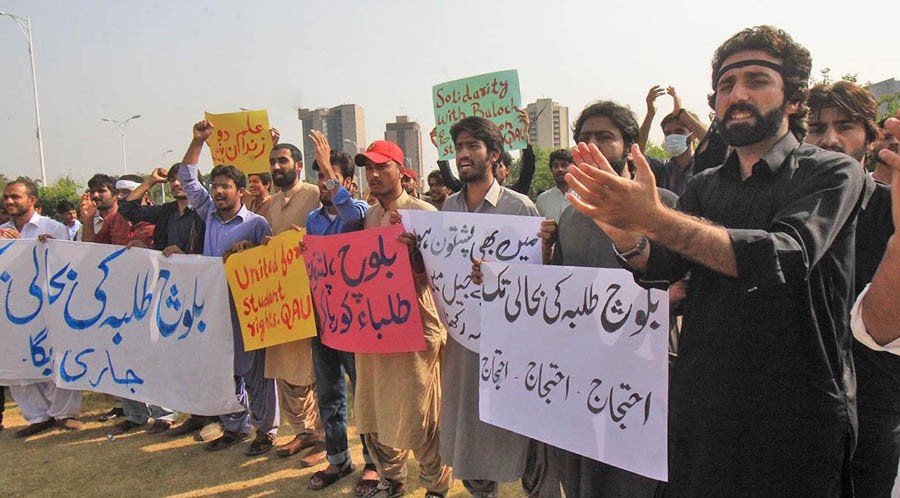
What has actually caused turmoil at Quaid-i-Azam University and how to manage it

For more than a month now, Quaid-i-Azam University (QAU) remained in turmoil. The triangle of conflict pitched students against students and students against the university’s faculty and administration. At its core, the issue seems to be one of capacity. The university’s intake of new students exceeds what the campus can accommodate efficiently. To a lesser extent, mishandling played due role in amplifying the crisis which could have been averted in the first place. Infighting between the vice-chancellor (VC) and faculty helped the crisis linger on.
The fighting between Baloch and Sindhi students can be understood in terms of the competing notions of primordialist and instrumentalist schools of thought. In May 2017, the Sindhi students under the banner of Mehran Council came to blows with Baloch Council. An ethnic Baloch from Sindh, the story ran, joined Baloch Council because, tracing his primordialist roots to Baloch origin, he believed he was a Baloch. The Sindhi students, giving precedence to the Baloch student’s modern identity over his traditional one, contested the Sindhi Baloch credentials to be Baloch on the ground that the latter was domiciled in Sindh and spoke Sindhi as mother tongue.
For Sindhi students, the self-professed Baloch was a turncoat and deserved penalty. He was beaten. The Baloch Council responded in kind because the Sindhi students triggered fighting in the first place, alleged Baloch students I spoke to.
The video footage, widely aired on social media, of students jumping from rooftop as others chased them added to the urgency of taking strict action against the culprits. As a result, 26 Sindhi and 7 Baloch students were rusticated for two semesters with 6 and 2 students expelled from each council respectively. For the last two weeks, Baloch students were on strike at the campus demanding the reinstatement of their two expelled fellows on the ground that they informed the administration in advance to anticipate the brawl, a claim confirmed by a faculty member who is also discharging administrative duty. The teacher also said that although police were deployed but due to lack of coordination between the Islamabad City Police and the university administration fighting could not be prevented. Thus, timely action could have prevented violence in the first place.
On the reinstatement question, which virtually happened with the reinstatement of all expelled and rusticated students by commuting penalty to fines of Rs40,000 and Rs25,000 respectively, the university administration was in a quandary. Some faculty members, believing that discipline must not be compromised, had warned to go on strike if the expulsion was not upheld. Others were in favour of restoration on humanitarian grounds.
There was another thread to the story. A number of faculty members, few of whom have personal grievances against the VC, had formally demanded resignation of the incumbent officer. For the VC, revoking students’ expulsion called for the ire of the faculty. On the other hand, protesting students, few of whom were on hunger strike, were rushed to hospitals due to deteriorating health. A referendum, on the question as to whether the sitting VC should stay on or not, took place on exactly the same day, Nov 9, on which restoration was announced. 120 faculty members voted for the resignation of the VC against 42 who wanted him to continue.
A teacher, speaking on the authority of academic staff association cabinet, said that strike won’t be observed though. Put differently, the crisis would not have lingered on had it not been for the reason of infighting between the faculty and VC.
What has mainly caused the disruption?
The reason mainly lies in the failure to accommodate the huge influx of students after the introduction of the BS programmes on the campus a couple of years ago. For a casual visitor who would visit the varsity a few years back, the once quiet campus is swarmed with students with hardly some, if any, corresponding arrangement to accommodate the ever-increasing intake of the new entrants. Consequently, students voice concerns over a number of issues. The erection of concrete walls, the laying of barbed wires and barriers have turned the until-recently open spaces, as characteristic of QAU, into restricted areas. Similarly, students have been issued explanations and show-cause notices on as petty things as the celebration of a birthday party. Some students interpret these moves as the growing "Islamisation of the once liberal institute of learning".
Over myriad problems that students faced, the Quaidian Student Federation (QSF), the parent body of all ethnic councils at the QAU, called for the strike, which continued in October for two weeks. QSF placed twelve demands that included among others reduction in fee, increase in the number of buses and hostels, the removal of barriers and the improvement of sports facilities. Frustration played itself out.
Large induction is a matter of concern for the teaching staff. Discouraging entertainment is not meant to Islamise the campus, they contend. The playing of music and celebrating birthday parties, in the vicinity of classes, during the official hours disturb routine academic activities such as tacking class, they maintain. Teachers speak of the declining quality of students’ intake on self-finance. Most of these students, poised to disrupting the academic environment, have a very casual attitude towards studies, they say. To remedy the issue, there is some consideration in the university to decrease the number of new admissions.
How to manage the crisis?
At administrative level, the university should timely respond to any crisis. Solutions to many of the issues that the QAU is mired in lie in going back to the basics: restoring the campus to its core values of receptiveness to critical thinking, diversity and being least concerned with what is moral but what is academic against a backdrop of openness of its picturesque landscape in a calm countryside settings. In the immortal words of E F Schumacher, "small is beautiful" because it is manageable; it is sustainable too!